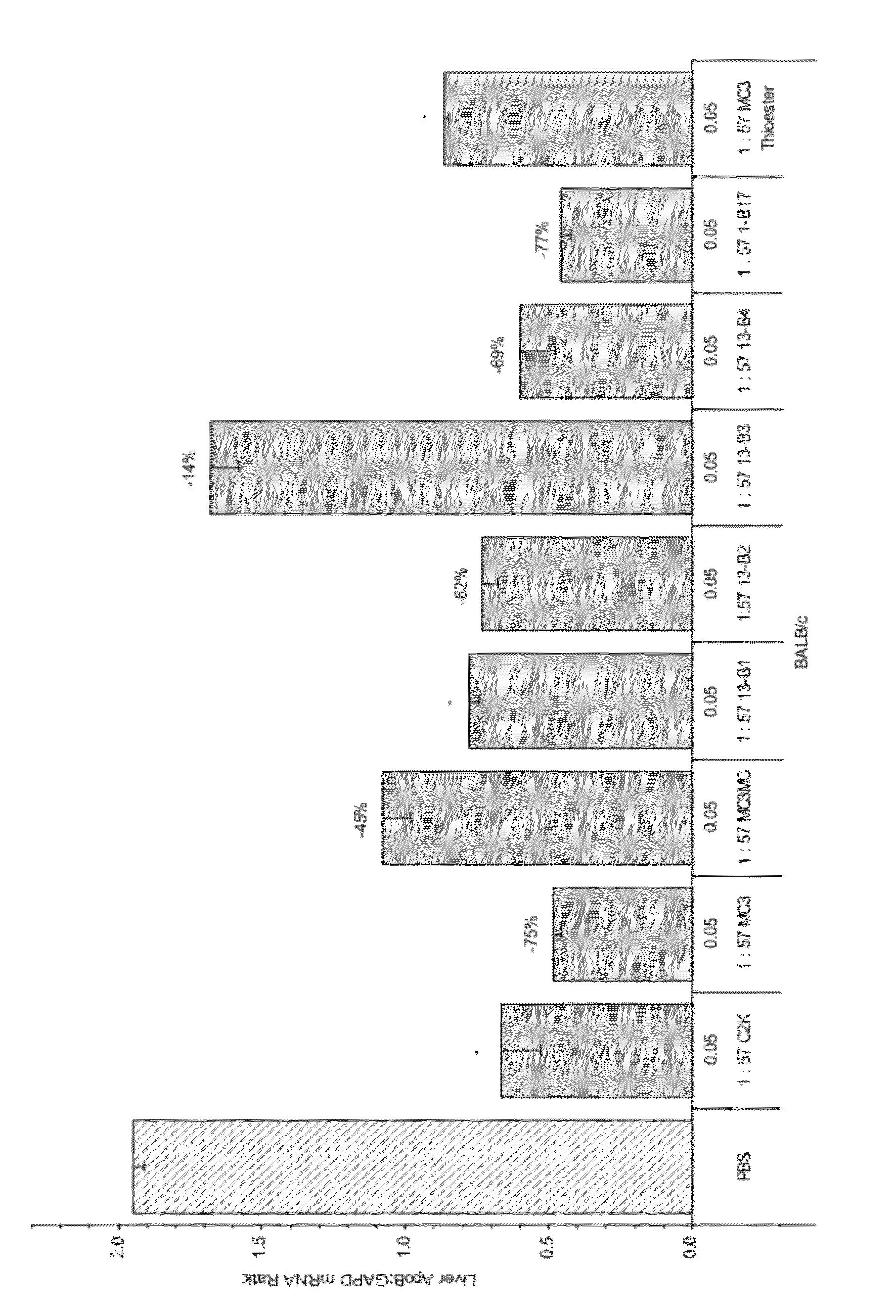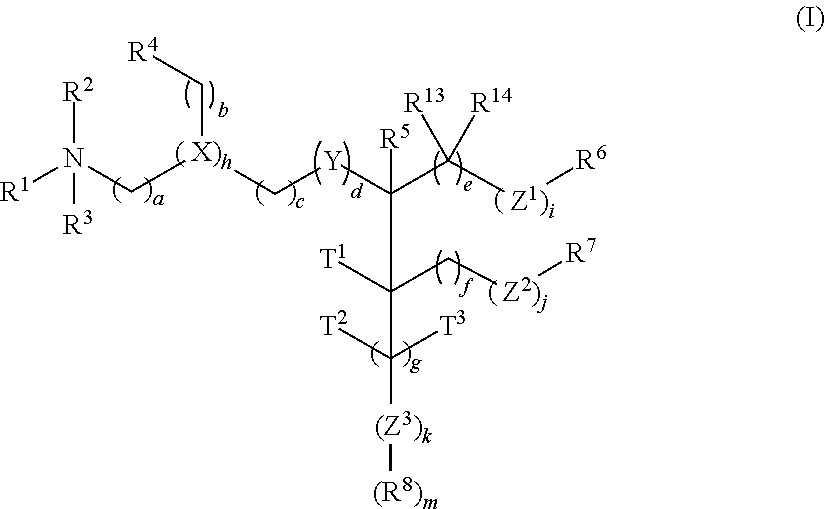Trialkyl cationic lipids and methods of use thereof
a technology of cationic lipids and lipids, which is applied in the field of trialkyl cationic lipids, can solve the problems of reducing affecting the stability of the construct, and affecting the activity of the construct, so as to achieve stable circulation
- Summary
- Abstract
- Description
- Claims
- Application Information
AI Technical Summary
Benefits of technology
Problems solved by technology
Method used
Image
Examples
example 1
Synthesis of 13-B1
Synthesis of compound 13-B1,(13Z,16Z)-4-hydroxy-4-((9Z,12Z)-octadeca-9,12-dienyl)-3-((9Z,12Z)-octadeca-9,12-dienyloxy)docosa-13,16-dienyl 4-(dimethylamino)butanoate, having structure (B) below, was synthesized as described in Scheme 7 below
[0520]
Step 1: Synthesis of 3-((9Z,12Z)-octadeca-9,12-dienyloxy)dihydrofuran-2(3H)-one, having the structure below
[0521]
[0522]To a solution of α-hydroxybutyrolactone (2.0 g, 19.6 mmol) and linoleyl methane sulfonate (5.4 g, 15.7 mmol) in anhydrous DMF (60 mL), was added cesium carbonate (8.0 g, 24.5 mmol). The solution was stirred overnight under nitrogen at 80° C. Upon completion, the reaction was poured into water (100 mL) and extracted with ethyl acetate (3×100 mL). The combined ethyl acetate extracts were washed with brine (3×50 mL), dried on magnesium sulfate, filtered and concentrated in vacuo to dryness. The residue was purified by column chromatography on silica gel 60 (eluted with 10% ethyl acetate in hexanes) to afford 3...
example 2
Synthesis of 13-B3
[0527]See steps 1 and 2 of Example 1.
Step 3: Synthesis of compound 13-B3,(13Z,16Z)-4-hydroxy-4-((9Z,12Z)-octadeca-9,12-dienyl)-3-((9Z,12Z)-octadeca-9,12-dienyloxy)docosa-13,16-dienyl 3-(dimethylamino)propanoate, having the following structure, was synthesized as described above in Scheme 7 for structure (A)
[0528]
[0529]To a solution of (14Z,17Z)-4-((9Z,12Z)-octadeca-9,12-dienyl)-3-((9Z,12Z)-octadeca-9,12-dienyloxy)tricosa-14,17-diene-1,4-diol (1.5 g, 1.73 mmol), 4-(dimethylamino)propanoic acid hydrochloride (500 mg, 3.3 mmol), EDCI hydrochloride (750 mg, 3.9 mmol), DIPEA (225 μL, 1.3 mmol) in anhydrous dichloromethane (15 mL) was added DMAP (5 mg). The solution was stirred at room temperature under nitrogen for 20 hours. Upon completion, the solution was concentrated in vacuo to dryness and purified by column chromatography on silica gel 60 (eluted with 1:1 hexanes / Ethyl acetate) to afford (13Z,16Z)-4-hydroxy-4-((9Z,12Z)-octadeca-9,12-dienyl)-3-((9Z,12Z)-octadeca-9,...
example 3
Synthesis of 13-B2
[0530]Compound 13-B2, having structure (C) below, was synthesized as described in Scheme 8 below.
[0531]
Step 1: Synthesis of (6Z,9Z,29Z,32Z)-19-((9Z,12Z)-octadeca-9,12-dienyl)octatriaconta-6,9,29,32-tetraene-19,20-diol, having the following structure
[0532]
[0533]A 100 mL round bottom flask was charged with magnesium turnings (360 mg, 14.6 mmol) and a stir bar. The flask was dried with a heat gun for 5 minutes then cooled under nitrogen. The flask was charged with THF (5 mL) and a small grain of iodine. A solution of linoleyl bromide (4 g, 12.1 mmol) in THF (5 mL) was added slowly and after 5 minutes the reaction initiated vigorously. The solution was stirred at room temperature for 2 hours, and then ethyl glyoxalate (0.5 mL, 2.42 mmol, 50% solution in toluene) was added. The exothermic reaction was finished immediately and quenched with saturated ammonium chloride solution (5 mL). The solution diluted with water and extracted with diethyl ether (3×50 mL). The combine...
PUM
| Property | Measurement | Unit |
|---|---|---|
| mol % | aaaaa | aaaaa |
| mol % | aaaaa | aaaaa |
| mol % | aaaaa | aaaaa |
Abstract
Description
Claims
Application Information
 Login to View More
Login to View More - R&D
- Intellectual Property
- Life Sciences
- Materials
- Tech Scout
- Unparalleled Data Quality
- Higher Quality Content
- 60% Fewer Hallucinations
Browse by: Latest US Patents, China's latest patents, Technical Efficacy Thesaurus, Application Domain, Technology Topic, Popular Technical Reports.
© 2025 PatSnap. All rights reserved.Legal|Privacy policy|Modern Slavery Act Transparency Statement|Sitemap|About US| Contact US: help@patsnap.com



